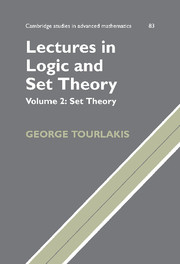I - A Bit of Logic: A User's Toolbox
Published online by Cambridge University Press: 12 January 2010
Summary
This prerequisite chapter – what some authors call a “Chapter 0” – is an abridged version of Chapter I of volume 1 of my Lectures in Logic and Set Theory. It is offered here just in case that volume Mathematical Logic is not readily accessible.
Simply put, logic is about proofs or deductions. From the point of view of the user of the subject – whose best interests we attempt to serve in this chapter – logic ought to be just a toolbox which one can employ to prove theorems, for example, in set theory, algebra, topology, theoretical computer science, etc.
The volume at hand is about an important specimen of a mathematical theory, or logical theory, namely, axiomatic set theory. Another significant example, which we do not study here, is arithmetic. Roughly speaking, a mathematical theory consists on one hand of assumptions that are specific to the subject matter – the so-called axioms – and on the other hand a toolbox of logical rules. One usually performs either of the following two activities with a mathematical theory: One may choose to work within the theory, that is, employ the tools and the axioms for the sole purpose of proving theorems. Or one can take the entire theory as an object of study and study it “from the outside” as it were, in order to pose and attempt to answer questions about the power of the theory (e.g., “does the theory have as theorems all the ‘true’ statements about the subject matter?”), its reliability (meaning whether it is free from contradictions or not), how its reliability is affected if you add new assumptions (axioms), etc.
- Type
- Chapter
- Information
- Lectures in Logic and Set Theory , pp. 1 - 98Publisher: Cambridge University PressPrint publication year: 2003



